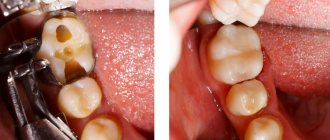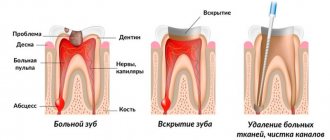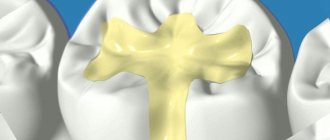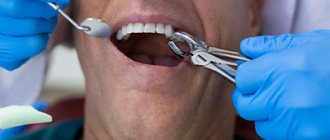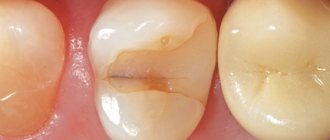Symptoms of needing root canals
If you experience prolonged pain from cold or hot water, lasting several minutes, you should suspect inflammation of the nerve in the tooth. The pain can increase gradually, occur after a filling is placed, or with severe tooth decay due to a cold, decreased immunity, stress, or hypothermia. If pain occurs when food hits a certain tooth, when you press on it or tap it with a spoon, then you can assume inflammation of the apical tissues around the root - periodontitis. Cleaning the canals, treating them with medication and filling them is necessary to prevent the spread of inflammation to neighboring areas. In severe cases, complications such as periostitis, osteomyelitis, abscess or phlegmon develop, the latter is treated in a hospital. If the nerve or gangrenous tissue from a tooth is not removed in time, the risk of losing the tooth itself increases over time.
How much does a temporary filling with arsenic cost?
The period for which a temporary filling with arsenic can be left in a tooth depends on various circumstances - the age of the patient, the condition of his teeth, as well as the means used by the dentist to kill the pulp. When setting the time frame, the option of placing the drug is also taken into account - on an unopened pulp chamber or directly on the exposed pulp.
Typically, a temporary filling with arsenic remains in the tooth for a day, but when treating multi-channel chewing teeth, this period can be increased to two days. When treating baby teeth with formed roots, this time is reduced to 18 and 24 hours, respectively. And if the latest generation of arsenic preparations are used, they can be left in the tooth for up to five days.
If you have been given a temporary filling with arsenic, you must strictly adhere to the deadlines and come to replace it at the time specified by the doctor. Prolonged residence of the drug in the tooth leads to the penetration of arsenic into neighboring tissues and its accumulation there, which can ultimately provoke periodontal inflammation.
Pain after nerve removal and root canal treatment
One of the most common misconceptions among patients is that a tooth without a nerve cannot hurt. In principle, there is truth in this. But it's not that simple. Nerve fibers exit the tooth through the apical foramen in the root and unite into common trunks, thicker and more powerful. Such a trunk may be responsible for the sensitivity of the entire half of the jaw or face. This explains the irradiation (passage) of pain along the entire nerve if the inflammation affects only one tooth. The impulse is transmitted through nerve fibers to neighboring areas - ear, temple, eye, eyelid, forehead, etc. When a nerve is removed (tooth depulpation), it is simply torn off from the main trunk, causing inevitable injury to the tissues. Canal cleaning takes place under anesthesia and the patient does not feel the moment the instrument exits through the tooth. Without proper control over this procedure, a hematoma (local hemorrhage) may form in the area of the apex of the tooth root, which will cause pain when pressing on the tooth or clenching the jaws. A feeling of mild pain in a pulpless tooth is acceptable for 1–2 days. As a rule, with high-quality cleaning of the contents of the tooth cavity, there is no painful reaction from temperature stimuli (cold or hot water), no severe throbbing or aching pain. If the doctor removed the nerve from the tooth, treated the canals and left a turunda with an antiseptic in them, the tooth should not hurt. If, some time after treatment, the patient notices severe pain, which intensifies in the evening or at night, it is necessary to re-clean and rinse the root canals. This needs to be done as quickly as possible; you should not endure the pain or relieve it with medications. Short-term help can be provided by painkillers: Pentalgin, Ketanov, Tempalgin and others.
The occurrence of throbbing pain from hot water after root canal filling
Treatment of tooth canals involves not only treating, cleaning and drying them, but also filling them with special filling materials. As a rule, pastes for these purposes are used with or without anti-inflammatory additives. Filling the canals is necessary in order to eliminate the possibility of creating conditions for the growth of bacteria. When the tooth cavity is densely filled with gutta-percha pins and paste, there are no such conditions. If some of the infected tissue gets behind the root apex during canal treatment, the inflammation spreads to the bone. Pain in the tooth appears almost immediately after root canal treatment or during the first days and has a certain character: pulsating, twitching, shooting, aggravated by heat. In order to eliminate such a complication, it is necessary to carefully treat the tooth canals using the correct technique. If such pain occurs, it is necessary to re-treat the canals; a short-term effect is achieved by taking painkillers with an anti-inflammatory effect: Nise, Ibuprofen. In some cases, rinsing the mouth with a warm soda solution (1 teaspoon of salt and soda per glass of water) has a positive effect.
Reasons why a tooth hurts after treatment
It would seem that if you went to the dentist and had your tooth treated, it shouldn’t hurt, but quite the opposite, if it hurt, then everything should go away. In fact, it happens that after treatment the tooth may hurt. Sometimes this is a normal reaction to certain medical manipulations and the doctor warns the patient about this. And sometimes, these are undesirable and, moreover, most often predictable consequences of treatment.
So, let’s look at the norm: when a tooth hurts and this is normal. Firstly, it is worth noting that the pain that a person experiences is dull, aching, and not pronounced. Such sensations can occur both after caries treatment and after endodontic root canal treatment.
For example, after treatment of deep caries, sensitivity may occur when biting on a tooth; if the cavity is located in the cervical part of the tooth, then there is a high probability of sensitivity to temperature irritants. But these are all temporary phenomena that should pass after a short period of time. Similar symptoms may occur after treatment of wedge-shaped defects. To properly close such a defect, it is necessary to place a so-called retraction thread under the gum, thanks to which the filling material can be applied without an overhanging edge. As a result of this, the neck of the tooth, which was previously covered by the gum, becomes exposed. And, as you know, the neck is the most sensitive area, since it is there that the nerve is located closest to the surface of the tooth. This phenomenon is also temporary until the gums recover and cover the exposed area of the tooth.
Also, certain pain sensations may occur after endodontic treatment. This does not happen very often, but despite this, doctors usually warn patients about this possibility. The pain is usually not severe and occurs when biting on a tooth. Such pain is called post-filling pain.
Despite all modern treatment methods, there are situations when, after treatment, teeth hurt so much that people do not sleep all night. This, in fact, happens and it cannot be said that it is very rare. Let's look at a couple of examples.
When treating deep caries, in an attempt to save the tooth alive and not resort to depulping it, the doctor places a filling. According to the idea, this should be a temporary, so-called diagnostic filling. Thanks to which the dentist gets an idea of the vitality and infection of the pulp. The patient should be warned that the tooth may become sick and then, in this case, the tooth will have to be depulped. If after some time the tooth does not make itself felt, the temporary filling is replaced with a permanent one and the tooth remains alive.
The second option is when, after depulping and even permanent root canal filling, severe evening, night, and spontaneous pain may occur. This can occur when the pulp is not completely removed. On the one hand, this may indicate poor-quality endodontic treatment, and on the other, about the peculiarities of the anatomical structure of the tooth.
In cases where a tooth hurts after treatment, if you are bothered by an acute toothache, if you feel severe pain after tooth extraction, then you need to contact your dentist in a timely manner, and not try to drown out a severe toothache with medications, which can lead to even more serious complications.
Pain in the tooth after canal treatment, if there is a focus of inflammation in the bone
If a patient comes in with pain that intensifies when food hits the tooth, with a feeling of internal pressure from inside the tooth, almost always in such cases there is inflammation in the bone or around the root. This situation occurs when the nerve is destroyed, rots and the entire infection comes out of the tooth into the bone, forming an inflammatory focus - a cyst or granuloma. Treatment in this case is quite complicated, and the tooth cannot always be saved. If the doctor believes that there is a chance to cure the inflammation, he treats the root canals and leaves turunda with an anti-inflammatory solution or medicinal paste in them under a temporary filling for 1–2 weeks, after which he fills the canals with permanent hardening materials. In some cases, the pain does not go away immediately. Therapeutic agents gradually take effect, so the first few days after treatment the tooth may hurt. As a rule, in such cases, additional treatment is prescribed in the form of anti-inflammatory tablets (Nise, Ibuprofen), antibiotics (Amoxiclav, Lincomycin) or antimicrobial agents (Trichopol). Rinsing with warm soda solution helps relieve pain.
There is no need to be afraid of root canal treatment and nerve removal. Modern pain relievers will effectively help you carry out the entire procedure without any pain. Mechanical preparation of hard tissues, cleaning of the tooth cavity, treatment and filling of root canals are necessary procedures, but they should be carried out in compliance with all the rules. High-quality root canal treatment is the key to tooth preservation.
Content:
- When is a non-permanent filling indicated?
- Why does a tooth with a temporary filling hurt?
- When to sound the alarm
- What to do if a tooth hurts under a temporary filling
- Preventive measures
Most often, people rush to the dental clinic because of pain.
Naturally, every person hopes that he will return home with a healthy tooth. Unfortunately, this is not always the case. Often in dental practice there are situations when the doctor has to put a temporary filling instead of a permanent one. It is distinguished by its low cost and loose structure. It is loosely held in the carious cavity and quite quickly falls out on its own or decreases in volume. These features are due to the fact that the temporary filling material must be easily removed. The problems it solves:
- protection of the carious “hollow” from the accumulation of food debris and the penetration of pathogenic bacteria;
- preventing premature loss of medication from the “hole”.
How to treat a tooth if there is still pain in it after refilling?
If a patient at a dental clinic has undergone root canal retreatment and is constantly in pain after refilling, it is necessary to contact a specialist. To eliminate the problem, the doctor will perform the following dental procedures:
- Unseals previously resealed canals.
- Will carry out their cleaning and antiseptic treatment.
- Apply antibacterial paste.
- Places a temporary filling.
After eliminating the inflammatory process, the temporary filling is removed, the dental canal is re-cleaned and a permanent filling material is placed.
Deputy chief physician
Brodsky Sergey Evgenievich
Sign up for a free consultation
+7
All endodontic procedures should be carried out only using a special dental microscope. Its use helps dentists greatly increase the working area, resulting in increased quality and efficiency of treatment. In addition, the use of a microscope allows you to prevent damage to healthy tissue and minimize the risks of developing possible complications.
Which dental clinic in Moscow should I choose if I have toothaches left after root canal retreatment? Patients who have undergone root canal treatment, but after treatment the tooth does not stop hurting, should think about changing clinics and dentists. In Moscow, according to numerous reviews from patients, the Partner-Med clinic is considered the best place for such treatment. The highly qualified specialists working in it are able to cope with the most complex dental problem and save the tooth even with minimal chances of this. Among the advantages of our clinic over other dental centers in the capital are:
- Free initial consultation.
- Selection of therapeutic procedures in accordance with the patient’s indications and financial capabilities.
- Affordable prices and frequent promotions for dental services. Currently there is a promotion for endodontic treatment under a microscope.
Just CALL US!
+7
We will answer any of your questions and will definitely help you!
Request a call back or dial our number!
+7
This phone call does not obligate you to anything. Just give us a chance and we will help you!
Just pick up the phone and call us!
+7
We will definitely make you an offer that you cannot refuse!

